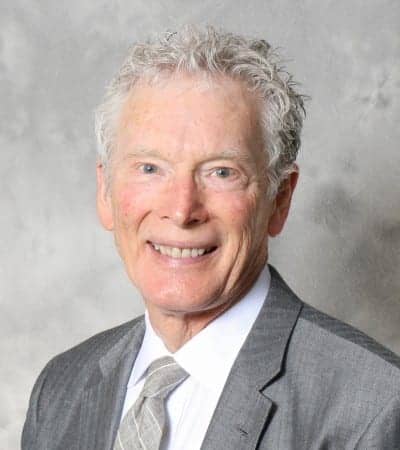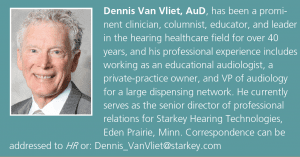Final Word | September 2017 Hearing Review
This summer, I was fortunate to be able to attend the 15th Annual Symposium on Cochlear Implants in Children (CI2017) meeting in San Francisco, which was organized by the American Cochlear Implant Alliance, Stanford University School of Medicine, and the University of California, San Francisco. I was fortunate because, although I was a pediatric audiologist early in my career, I have spent most of my professional life thinking about and working with hearing aids and related technology. As a result, presentations, posters, and papers focusing on cochlear implants have largely not held my interest other than for me to gain enough of a knowledge base for appropriate referrals.
The risk we face as professionals in behaving as I have is that we unwittingly sign on as members of a silo that does not contain the full scope of information for a broad range of practice. I was pleasantly surprised at how the content of this meeting captured and held my attention, introducing me to a broader scope of information and overlap with hearing aids.
Three examples that helped move me out of my comfort zone:
Cochlear implantation for individuals with unilateral hearing loss. CROS and bone-anchored devices have some utility in bringing sound from the side without hearing over to the better ear. There are well-reported advantages and limitations for these approaches. What cannot be done is to provide true binaural hearing with these devices. While not approved in the United States for standard treatment in cases of unilateral hearing loss, cochlear implantation is being studied, with reportedly encouraging early results. Those of us working with hearing aids, and the increasingly broader array of CROS systems available, will need to follow these developments to better discuss options for the patients we see with unilateral hearing loss.
Hybrid electric-acoustic fittings. As the surgical approaches improve for cochlear implants and the criteria for implantation creep into the range of hearing often fit with hearing aids, preservation of residual hearing in implanted ears is getting attention. Electric stimulation that focuses on the envelope of speech produces benefit for speech, but misses the fine structure that brings much of the beauty of suprasegmental elements of speech and music appreciation. Low-frequency acoustic stimulation for those ears with adequate residual hearing may provide benefit. The options for hybrid devices, or the option of adding a separate acoustic device, raises the possibility of bringing some implanted patients back into the scope of practice for those of us who have been fully releasing them to implant centers for management.
A related unsustainable complication for implant centers is the problem of limited resources. While cochlear implants are covered by many insurance policies, the required assessment, programming, and follow-up, non-medical audiologic services are often under-compensated or not covered. One presentation at the meeting offered a model that referred all post-implant programming and service back to the manufacturer. In this time of disruption in the delivery of service and products for hearing devices, there may be additional opportunities for providing needed care for these patients.
Early language exposure and intervention for pediatric patients. Early intervention has been recognized as key for children with hearing impairment for decades. Multiple speakers at this meeting provided convincing evidence that early cochlear implantation for children with profound deafness provides those patients with better outcomes than those who did not receive implants until later.
The clear consensus was the earlier, the better. The US Food and Drug Administration (FDA) approves implants for deaf children 12 months of age and older. Speakers offered arguments that children implanted at 6 months had better outcomes than those implanted at 12 months.
Similarly, the arguments for multiple communication modalities, such as signing along with oral communication, have been accepted as best practice by many teachers and language experts working with deaf children. However, there are many post-implant early intervention programs that do not use signing. There have been long-standing differences of opinion on the best way to approach language training for deaf and hearing-impaired infants. There is recognition that American Sign Language (ASL) is a proper language and may prepare deaf and hearing impaired children for a productive life. At the same time, when a child has the opportunity to develop oral communication, as is the case today with cochlear implants, what approach should be taken for the best outcomes?
Yoshinaga-Itano et al1 found that children with hearing loss who were identified by 6 months of age demonstrated better language scores than children who were identified after 6 months of age. The advantage held across all test ages, communication modes, and socioeconomic strata. This paper and others supports the belief that language provided in any modality with early intervention could be recognized as best practice for infants with normal cognitive abilities.
Cochlear implant use even with early implantation does not guarantee that spoken language will emerge as with typical children. Since controversy persists whether spoken language in combination with sign language provides greater benefit from a cochlear implant than spoken language alone, a multi-site, multi-year study2 was conducted to address whether the use of sign language before and after cochlear
implantation favorably influences auditory speech recognition, speech and language production, and reading outcomes. Andrea Warner-Czyz, PhD, a coauthor of the study2 that was published online in the July edition of Pediatrics, presented an overview of the findings at the CI2017 Symposium:
Participants: (n=97)
Implanted at 38 months or less
Parents were typical hearing
- No sign (n = 35): No sign used pre-implant or the first 3 years post-implant;
- Short-term sign (n = 26): Sign used pre-implant and/or 1 year post-implant, but discontinued, and;
- Long-term sign (n = 36): Sign used pre-implant and at least 2 years post-implant.
The baseline characteristics of the three groups were matched on a variety of demographic, performance, and experience factors. Outcomes were compared from these three groups that differed primarily with respect to the amount and duration of sign language used. The researchers found:
RESULTS: Children without early sign language exposure achieved better speech recognition skills over the first 3 years post-implant and exhibited a statistically significant advantage in spoken language and reading near the end of elementary grades over children exposed to sign language. Over 70% of children without sign language exposure achieved age-appropriate spoken language compared with only 39% of those exposed for 3 or more years. Early speech perception predicted speech intelligibility in middle elementary grades. Children without sign language exposure produced speech that was more intelligible (mean = 70%) than those exposed to sign language (mean = 51%).2
Dr Warner-Czyz emphasized the importance of responsible interpretation of the study. While the data are compelling, it is important to keep in mind that there are individual differences as displayed in the data plots. These children were of parents with typical hearing and varying competence with sign language. The exposure to sign language was by parental report.
The Geers et al study2 has renewed a lively discussion about intervention for children who are receiving cochlear implants. Responsible interpretation of the data should include the fact that this was a specific study with a well-matched cohort. Broad generalizations to other populations would be inappropriate.
The Final Word? Conferences with information in a continuing education format are typically designed to provide us with current and evolving information. I learned a powerful lesson by stepping outside my comfort zone into another silo and gained new insights as a result. I highly recommend exploring outside our direct interests and becoming a little uncomfortable now and then.
For those interested, the 2018 Annual Symposium on Cochlear Implants in Children (CI2018) will be held March 7-10 at the Omni Shoreham in Washington, DC. For more information, visit: http://www.ci2017sf.org
Citation for this article: Van Vliet D. A visit to CI2017…and why it’s valuable to move outside your “audiology comfort zone.” Hearing Review. 2017;24(9):48-50.
References
-
Yoshinaga-Itano C, Sedey AL, Coulter DK, Mehl AL. Language of early- and later-identified children with hearing loss. Pediatrics. 1998; 102(5); 1161-1171.
-
Geers AE, Mitchell CM, Warner-Czyz A, Wang N-Y, Eisenberg LS. Early sign language exposure and cochear implantation benefits. Pediatrics. July, 2017;140(1). doi: 10.1542/peds.2016-3489






